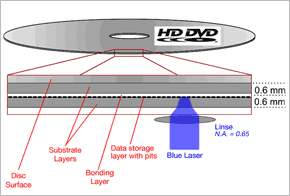Blu Ray Discs
Blu ray Discs and HD DVD The Next-Generation Disc Format The next-generation disc formats, Blu-ray Disc und HD DVD, have become very popular in the past few years, but as with all new technologies, many common questions still remain. What exactly makes these formats so unique? How are they better than a regular DVD? How do these formats relate to High Definition? We’ll shed some light on these and many of your common questions about Blu-ray Disc and HD DVD.
- Blue Laser Technology
- Structure of the disc formats
- What are the benefits of blue laser technology?
Blue Ray Discs Laser Technology
How are discs burned?
Optical data media consists of several layers. The laser burns the data on the data storage layer and then reads it from the same layer. The laser is a highly-concentrated light that burns the information as small grooves, called ridges, on the data storage layer. Whereas a red laser is used to burn CDs and DVDs, Blu-ray Discs and HD DVDs are burned with a blue laser.

Red laser, blue laser - what's the difference?
A blue light has a much smaller wavelength than a red light, thus the blue laser results in a stronger light concentration than the red laser. The point, which meets with the data storage layer, is smaller with a blue laser than with a red laser, therefore, the pits of a blue laser are smaller than that of a red laser. On a same-sized surface, a blue laser can burn more pits into the data storage layer than a red laser.
Higher density of pits with a blue laser media
Structure of the disc formats
The disc formats differ not only in the kind of laser used, but also in the physical structure.
DVD:
With a DVD the data storage layer in the middle layer of the disc. The laser must then penetrate 0.6 mm, relatively far, to reach the data storage layer. In doing so, light is lost and the concentration of the laser is not optimal.
HD DVD:
The HD DVD resembles a DVD in its structure. The blue laser penetrates to the data layer which is located, like on a DVD, in the middle layer of the disc. However, it can accommodate, as described above, substantially more data on the same surface space.
Blu-ray Disc:

With Blu ray Discs, the data storage layer is much closer to the laser itself, as it lies on the underside of the disc. Therefore, the laser needs to only reach through 0.1 mm of the data storage layer. The laser is optimally bundled due to the small distance and can be used more effectively. Because of this, Blu ray Discs can store the largest amount of data.
Physical structure of a Blu-ray Disc vs Physical structure of an HD DVD


Even more storage space
Did you know..
...HD in HD DVD doesn't mean High Definition, but High Density, as in a DVD that has an increased storage capacity.
In addition, Dual Layer Discs have two data storage layers. The Dual Layer Blu-ray Disc can hold 50 GB of data, while a Dual Layer HD DVD can hold 30 GB of data.But don’t think this is the final word in data storage. Lab tests have developed a triple-layer HD DVD with 51GB of storage and a quadruple-layer Blu-ray Disc with a storage capacity of 100 GB.
What are the benefits of a blue ray discs laser technology?
The new disc formats offer substantially more storage capacity and with it, a wide variety of possibilities. Business users can burn large amounts of data including entire data bases on a disc.
At home, users can benefit from the enormous quality enhancements of these features.
By the numbers
Blue ray discs lasers can accommodate High Definition films. A two-hour feature that fits on a normal DVD has a data size of 3.6 to 5.4 GB and a resolution of up to 720 x 576 pixels. One Blu-ray Disc or HD DVD, however, can fit a two-hour movie with a data size of 15 to 30 GB and a resolution of up to 1920 x 1080 pixels, with brilliant video and audio quality.
Interactive features
Did you know...
...in the name Blu ray Discs, the word "blue" is purposely misspelled since a color cannot be trademarked.
Movie fans find blue laser technology well worth the price. The large storage capacity of the discs brings a number of unique options. Besides presenting brilliant images and crystal-clear sound, the increased interaction options make the play back of blue laser discs particularly interesting. While the feature film plays, users can access information such as "the making of" scenes, commentary, and even quizzes about the film.
How do I use the new disc formats at home?
In order to play blue laser discs, a Blu ray Discs player or HD DVD player is required. Only a few compatible players are currently available on the market, however, Blu-ray Discs can be played back on PlayStation 3, and HD DVDs can be viewed with an Xbox 360 with an additional HD DVD hard drive.-Nero

